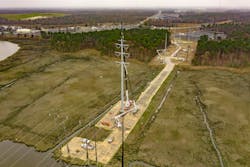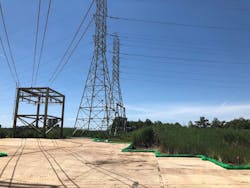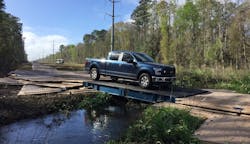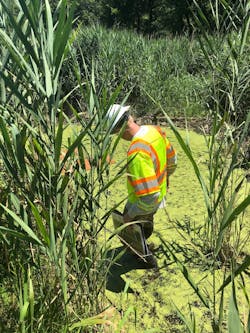Crews working in wetlands prioritize environmental sustainability and their own safety and protection
Building in environmentally sensitive areas, such as wetlands, poses challenges beyond just navigating waterways and stream channels.
It is critical to preserve plant and animal life and ensure that contractors are safe, even from potentially aggressive wildlife native to the habitat. In many cases, there are protected species to consider. The ongoing sustainability of the wetland is the key to performing such permitted work.
Fortunately, contractors do not have to manage these challenges alone. Specialty contractor partners in the rental business are experienced in providing recommendations for turnkey matting and access solutions. They can also oversee their installation in accordance with work specifications, permit requirements, and environmental standards. Renting the equipment and having experts on access solutions available helps facilitate the project’s success, allowing contractors to focus on the infrastructure construction at hand.
Assessing the project and following regulations
When initiating an access solution for a proposed wetland jobsite, a specialty contractor partner engages with the construction contractor on several levels. Among the first matters of assessment is the review of the Erosion and Sediment Plan (E&S) and the Storm Water Pollution and Prevention Plan (SWPPP) provided by an environmental consulting engineer working with the contractor—ideally followed by a joint site survey or job walk.
This job walk is essential to verify details about the wetland, because the initial plans received are often based on computer-generated data from Geographic Information Systems (GIS). These systems capture information about the wetland, terrain, and vegetation, but are not a substitute for a thorough on-site assessment.
A job walk allows the specialty contractor partner to capture photos and video and establish detailed notes about the wetland, which serve as a cross-reference to determine the accuracy of the GIS-generated plan. From there, the rental partner can present findings, including any potential hazards, to the project stakeholders to determine if safer alternatives to access the jobsite need to be integrated into the plan.
Following regulations is vital to avoiding job delays and penalties or fines. Construction in wetlands requires a strict adherence to environmental standards. It is subject to the Environmental Protection Agency (EPA) Clean Water Act, along with any regulations issued locally. The Clean Water Act Section 404, specifically, is a priority in wetlands, since it regulates how contractors discharge, dredge, and fill material to minimize the impact of flow into streams and tributaries. Specialty contractor partners, as part of their assessment of the area and the installation of the ground protection solution, can help contractors take the proper course of action to be in compliance.
Access solutions: Bridges & Matting
At times, reaching the main point of access to a wetland area is just as difficult as reaching the location where the construction will take place. It is imperative to follow the plan set for the job, working within the limitations of disturbance and adhering to all right-of-way requirements.
Depending on the need, there are several solutions for protecting jobsite grounds that can help alleviate these challenges and offer safe access over delicate wetlands and the plants and wildlife they contain.
Bridges: Trench crossing units provide a temporary roadway and are available in 15-ft lengths. Fixed-span bridges are available in spans of 20, 30, or 40 ft and are a good option for covering waterways, streams, and creeks. Such units and bridges can easily be dropped into place to provide access for equipment and workers to traverse the jobsite, while allowing water to flow naturally. Their HS-25 ratings ensure they can handle the heavy equipment and large vehicles and trucks typically found on such projects.
Modular bridges provide access across larger crossings and even rivers, and are a pre-engineered solution. Rental partners have the ability to design and install these in order to clear spans up to 270 ft. They include multiple components that are assembled at the site and then “launched” into place. These bridges are designed based on the identified area and loading, and are rated as HS-25 or higher depending on the application.
Matting: Composite matting is among the most versatile and popular options for accessing and protecting wetland areas during construction. Depending on the product used, a heavy-duty composite mat provides 84 to 91 sq ft of usable surface and is interlocking, allowing the installation of significant lengths of roadway or work pads for any application. It is also buoyant and stable, making it ideal for wetlands; the matting is rated at 600 lb per sq in. (psi) and is easily layered for additional stability. Composite matting performance in wet, muddy conditions is unmatched, aptly deflecting the weight of vehicles passing over, while also protecting the wetland plants and wildlife underneath. It provides a stable pathway for crew members and vehicles. The matting also helps keep crew members dry and safe from slips and falls, since it features an anti-slip tread and is free of the voids often found in wood matting alternatives.
In addition to durability and protection, composite matting offers other advantages. It is non-porous and has impermeable properties that make it ideal for wetland areas. The matting can be washed after use to prevent the transfer of invasive species of visible or microscopic plant life from one jobsite to another. It is also chemical-resistant and non-conductive, which is desirable from an environmental and safety perspective. Ultimately, composite matting is a sustainable access solution that allows contractors to leave wetland areas in their original state when construction has been completed. Plus, these properties make composite matting an ideal solution for such projects as traversing farmer fields and provide the additional benefit of minimizing soil compaction.
Once a project is complete and the composite matting is removed, the site can be restored to its original condition more quickly and at a lower cost to contractors. There are no large remnants of wood or steel left behind as can occur with other matting alternatives.
Safety is the priority
While safeguarding the wetland and its plant and animal life during construction is critical, so too is protecting the contractors and their crews. Safety is of utmost importance—prior to installing access solutions, while they are in use, and during their removal. Even though deadlines are tight on many projects and can be hindered by the terrain, weather, and other unpredictable occurrences, the first and foremost consideration is to provide safe access to and from the jobsite.



